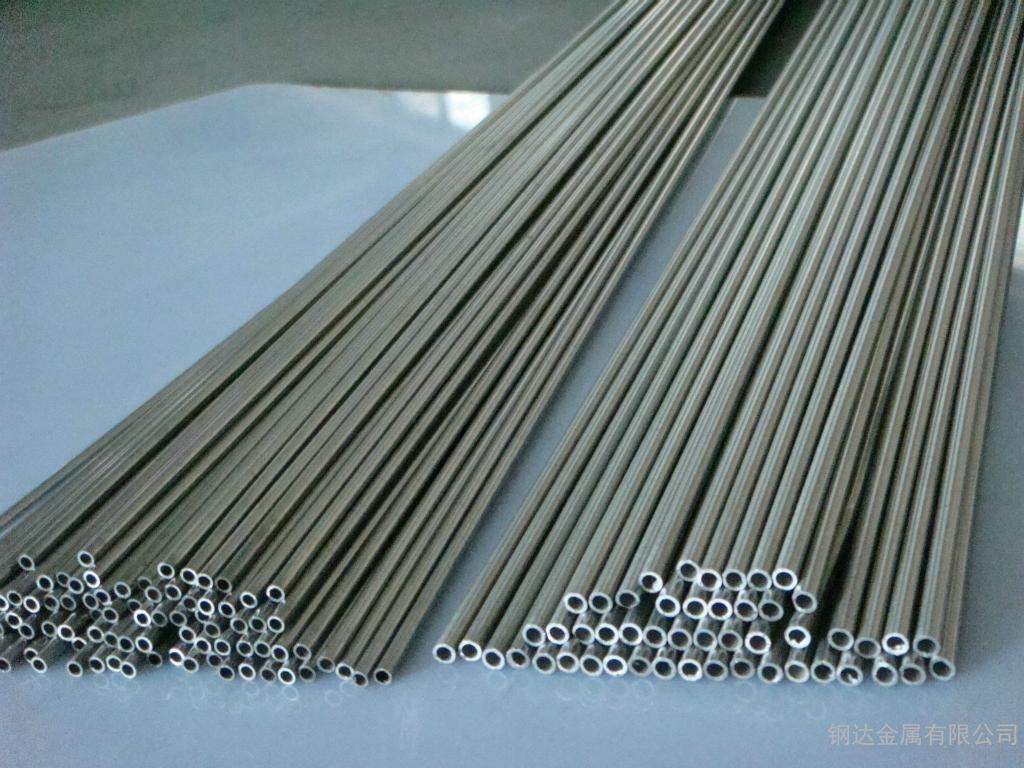Instrument Tubing Selection Guide
How to Select Instrument Tubing?
Instrument tube with fittings have been meticulously engineered to meet the diverse demands of various applications, ensuring optimal performance. However, the selection of tubing plays a pivotal role in maintaining system integrity and reliability. This guide aims to aid designers in choosing and ordering high-quality tubing, emphasizing proper selection and installation as essential for constructing leak-free and dependable tubing systems.
Instrument Tubing General Selection Criteria
The primary consideration in tubing selection is the compatibility of the tubing material with the intended media. Table 1 provides a comprehensive overview of common materials and their recommended applications, including the minimum and maximum operating temperatures. Its crucial to match tubing materials with like materials; for instance, stainless steel fittings should only be used with stainless steel tubing, except for brass fittings with copper tubing. Mixing materials is discouraged due to potential galvanic corrosion and variations in hardness, which can compromise fitting seals.
|
Tubing Material |
General Application |
Recommended Temperature Range |
|
Stainless Steel (Type 316) |
High Pressure, High Temperature, Generally Corrosive Media |
-425°F to 1,200°F1 (-255°C to 605°C) |
|
Carbon Steel |
High Pressure, High Temperature Oil, Air, Some Specialty Chemicals |
-20°F to 800°F2 (-29°C to 425°C) |
|
Copper |
Low Temperature, Low Pressure Water, Oil, Air |
-40°F to 400°F (-40°C to 205°C) |
|
Aluminum |
Low Temperature, Low Pressure Water, Oil, Air, Some Specialty Chemicals |
-40°F to 400°F (-40°C to 205°C) |
|
Monel® 400 |
Recommended for Sour Gas Applications Well Suited for Marine and General Chemical Processing Applications |
-325°F to 800°F (-198°C to 425°C) |
|
Hastelloy® C-276 |
Excellent Corrosion Resistance to Both Oxidizing and Reducing Media and Excellent Resistance to Localized Corrosion Attack |
-325°F to 1000°F (-198°C to 535°C) |
|
Carpenter® 20 |
Applications Requiring Resistance to Stress Corrosion Cracking in Extreme Conditions |
-325°F to 800°F (-198°C to 425°C) |
|
Inconel® Alloy 600 |
Recommended for High Temperature Applications with Generally Corrosive Media |
-205°F to 1200°F (-130°C to 650°C) |
|
Titanium |
Resistant to Many Natural Environments such as Sea Water, Body Fluids and Salt Solutions |
-75°F to 600°F (-59°C to 315°C) |
Instrument Tubing for Gas Service
Selecting tubing for gas service requires special attention to achieve a gas-tight seal. Ferrules in instrument fittings seal imperfections on the tubing surface by penetrating it. This penetration necessitates tubing with radial resistance softer than the ferrules, ideally achieved through thick-walled tubing. Tables 2-7 specify the minimum acceptable wall thickness for various materials in gas service. Additionally, Table 9 outlines acceptable tubing hardness, with softer materials yielding better results, particularly for gas service.
|
Table 2* 316 or 304 Stainless Steel (Seamless) |
||||||||||||||||
|
Tube O.D. Size |
Wall Thickness |
|||||||||||||||
|
0.010 |
0.012 |
0.014 |
0.016 |
0.020 |
0.028 |
0.035 |
0.049 |
0.065 |
0.083 |
0.095 |
0.109 |
0.120 |
0.134 |
0.156 |
0.188 |
|
|
1/16 |
5600 |
6900 |
8200 |
9500 |
12100 |
16800 |
|
|
|
|
|
|
|
|
|
|
|
1/8 |
|
|
|
|
|
8600 |
10900 |
|
|
|
|
|
|
|
|
|
|
3/16 |
|
|
|
|
|
5500 |
7000 |
10300 |
|
|
|
|
|
|
|
|
|
1/4 |
|
|
|
|
|
4000 |
5100 |
7500 |
10300 |
|
|
|
|
|
|
|
|
5/16 |
|
|
|
|
|
|
4100 |
5900 |
8100 |
|
|
|
|
|
|
|
|
3/8 |
|
|
|
|
|
|
3300 |
4800 |
6600 |
|
|
|
|
|
|
|
|
1/2 |
|
|
|
|
|
|
2600 |
3700 |
5100 |
6700 |
|
|
|
|
|
|
|
5/8 |
|
|
|
|
|
|
|
3000 |
4000 |
5200 |
6100 |
|
|
|
|
|
|
3/4 |
|
|
|
|
|
|
|
2400 |
3300 |
4300 |
5000 |
5800 |
|
|
|
|
|
7/8 |
|
|
|
|
|
|
|
2100 |
2800 |
3600 |
4200 |
4900 |
|
|
|
|
|
1 |
|
|
|
|
|
|
|
|
2400 |
3200 |
3700 |
4200 |
4700 |
|
|
|
|
1-1/4 |
|
|
|
|
|
|
|
|
|
2500 |
2900 |
3300 |
3700 |
4100 |
4900 |
|
|
1-1/2 |
|
|
|
|
|
|
|
|
|
|
2400 |
2700 |
3000 |
3400 |
4000 |
4500 |
|
2 |
|
|
|
|
|
|
|
|
|
|
|
2000 |
2200 |
2500 |
2900 |
3200 |
Instrument Tubing for System Pressure
System operating pressure dictates tubing material selection and sizing. High-pressure installations typically demand robust materials like steel or stainless steel, although copper may suffice if chemically compatible with the media. Steel or stainless steels superior strength allows for thinner tubes without compromising system integrity. Its imperative to adhere to recommended working pressures to ensure safety. Tables 2-7 provide maximum suggested working pressures for different tubing sizes and materials.
|
Table 3* 316 or 304 Stainless Steel (Welded) |
||||||||||||||||
|
Tube O.D. Size |
Wall Thickness |
|||||||||||||||
|
0.010 |
0.012 |
0.014 |
0.016 |
0.020 |
0.028 |
0.035 |
0.049 |
0.065 |
0.083 |
0.095 |
0.109 |
0.120 |
0.134 |
0.156 |
0.188 |
|
|
1/16 |
4800 |
5900 |
7000 |
8100 |
10300 |
14300 |
|
|
|
|
|
|
|
|
|
|
|
1/8 |
|
|
|
|
|
7300 |
9300 |
|
|
|
|
|
|
|
|
|
|
3/16 |
|
|
|
|
|
4700 |
6000 |
8700 |
|
|
|
|
|
|
|
|
|
1/4 |
|
|
|
|
|
3400 |
4400 |
6400 |
8700 |
|
|
|
|
|
|
|
|
5/16 |
|
|
|
|
|
|
3400 |
5000 |
6900 |
|
|
|
|
|
|
|
|
3/8 |
|
|
|
|
|
|
2800 |
4100 |
5600 |
|
|
|
|
|
|
|
|
1/2 |
|
|
|
|
|
|
2200 |
3200 |
4300 |
5700 |
|
|
|
|
|
|
|
5/8 |
|
|
|
|
|
|
|
2500 |
3400 |
4500 |
5200 |
|
|
|
|
|
|
3/4 |
|
|
|
|
|
|
|
2100 |
2800 |
3700 |
4200 |
4900 |
|
|
|
|
|
7/8 |
|
|
|
|
|
|
|
1800 |
2400 |
3100 |
3600 |
4200 |
|
|
|
|
|
1 |
|
|
|
|
|
|
|
|
2100 |
2700 |
3100 |
3600 |
4000 |
|
|
|
|
1-1/4 |
|
|
|
|
|
|
|
|
|
2100 |
2400 |
2800 |
3100 |
3500 |
4200 |
|
|
1-1/2 |
|
|
|
|
|
|
|
|
|
|
2000 |
2300 |
2600 |
2900 |
3400 |
4200 |
|
2 |
|
|
|
|
|
|
|
|
|
|
|
1700 |
1900 |
2100 |
2500 |
3000 |
Instrument Tubing Consider System Temperature
Operating temperature influences tubing material suitability, with copper and aluminum suitable for low temperatures and stainless steel or carbon steel recommended for higher temperatures. Special alloys like Alloy 600 are ideal for extreme temperatures (refer to Table 1). Table 8 presents derating factors for elevated temperature conditions, enabling the adjustment of working pressures listed in Tables 2-7 accordingly.
|
Temperature °F (°C) |
Copper Aluminum |
316 SS |
304 SS |
Steel |
Monel 400 |
||
|
100 |
(38) |
1.00 |
1.00 |
1.00 |
1.00 |
1.00 |
1.00 |
|
200 |
(93) |
.80 |
1.00 |
1.00 |
1.00 |
.96 |
.88 |
|
300 |
(149) |
.78 |
.81 |
1.00 |
1.00 |
.90 |
.82 |
|
400 |
(204) |
.50 |
.40 |
.97 |
.94 |
.86 |
.79 |
|
500 |
(260) |
|
.90 |
.88 |
.82 |
.79 |
|
|
600 |
(316) |
|
.85 |
.82 |
.77 |
.79 |
|
|
700 |
(371) |
|
.82 |
.80 |
.73 |
.79 |
|
|
800 |
(427) |
|
.80 |
.76 |
.59 |
.76 |
|
|
900 |
(486) |
|
.78 |
.73 |
|
.43 |
|
|
1000 |
(538) |
|
.77 |
.69 |
|
|
|
|
1100 |
(593) |
|
.62 |
.49 |
|
|
|
|
1200 |
(649) |
|
.37 |
.30 |
|
|
|
Instrument Tubing Ordering Guidelines
Ordering tubing for instrument fittings requires careful consideration to ensure performance and quality. Purchase orders should specify material, nominal outside diameter, wall thickness, and compliance with ASTM specifications to guarantee dimensional, physical, and chemical consistency. Additionally, users may impose more stringent requirements, such as scratch-free surfaces and suitability for bending. Table 9 provides specific ordering information for each material.
A well-structured purchase order should include the following details:
1/2" x .049" 316 stainless steel, seamless, or welded and redrawn per ASTM A-269. Fully annealed, 80 Rb or less. Must be suitable for bending; surface scratches and imperfections (incomplete weld seams) are not permissible.
|
Material |
Type |
ASTM Tubing Specifications |
Condition |
Max. Recommended Hardness |
|
|
Stainless Steel |
304, 316, 316L |
ASTM-A-269, A-249, A-213, A632 |
Fully Annealed |
|
90 Rb |
|
Copper |
K or L |
ASTM-B75 B68, B88 (K or L)* |
Soft Annealed Temper 0 |
60 Max. |
Rockwell 15T |
|
Carbon Steel |
1010 |
SAE-J524b, J525b ASTM-A-179 |
Fully Annealed |
|
72 Rb |
|
Aluminum |
Alloy 6061 |
ASTM B-210 |
T6 Temper |
|
56 Rb |
|
Monel® 400 |
400 |
ASTM B-165 |
Fully Annealed |
|
75 Rb |
|
Hastelloy® C-276 |
C-276 |
ASTM-B-622, B-626 |
Fully Annealed |
|
90 Rb |
|
Inconel® Alloy 600 |
600 |
ASTM B-167 |
Fully Annealed |
|
90 Rb |
|
Carpenter® 20 |
20CB-3 |
ASTM B-468 |
Fully Annealed |
|
90 Rb |
|
Titanium |
Commercially Pure ASTM B-338 Fully Annealed 99 Rb 200 Brinell Typical Grade 2 |
||||

Instrument Steel Tubing
请输入搜索关键字
确定






